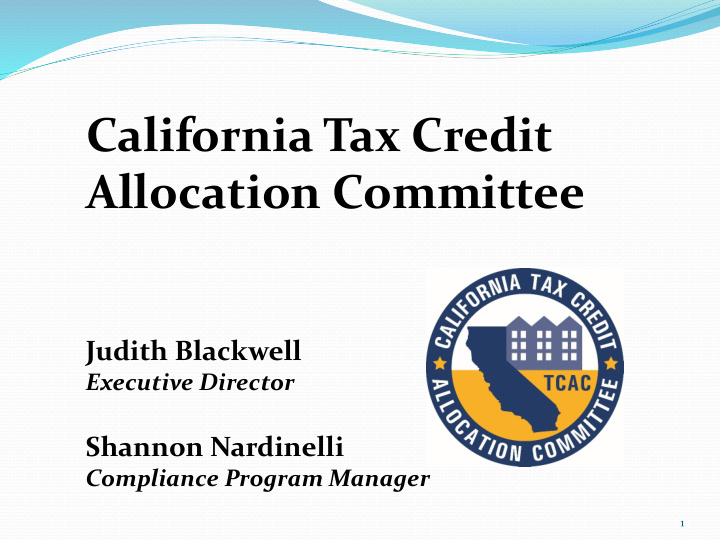



California Tax Credit Allocation Committee Judith Blackwell Executive Director Shannon Nardinelli Compliance Program Manager 1
Overview of Low-Income Tax Credit Properties 2
Not a traditional subsidy program Provides a “tax credit” to the developer and owner of the property if they provide housing that is income and rent restricted at or below 60% of the Area Median Income (AMI) average. Recent Legislation allows the limits to adjust from 20% to 80% of AMI for new housing as of 2018 but does not affect existing housing.
Tax Credit Properties The Numbers California currently has 5209 Tax Credit Projects 1691 are in Preliminary Reservation New projects that are either still in construction or are currently leasing up but have not received credits yet 2817 are in the Federal Compliance Period 701 are in the Extended Use Period All properties are mapped on our website at: www.treasurer.ca.gov/ctcac/projects.asp 4
5
Tax Credit Properties The Numbers The Greater Bay Area has 765 Tax Credit Projects Alameda Contra Costa San Francisco Marin San Mateo 6
Greater Bay Area 7
San Francisco and Oakland 8
Tax Credit Properties The Types 495 Projects are “Family Centric” Multiple Bedroom Sizes Amenities designed for Families and Children Play Areas After School Programs Educational Classes 9
Tax Credit Properties The Types 167 Projects are “Senior Centric” Age Requirements for occupancy Either 55+ or 62+ Amenities designed for Adult Populations Service Coordinator Adult Education or Health and Wellness Classes 10
Tax Credit Properties The Types 103 Projects are Special Needs/Single Room Occupancy Additional Amenities and Services designed to serve targeted populations Homelessness Disability Mental Health Issues Services include : Case Manager Educational Classes Health or Behavioral Health Services Service Coordinator 11
12
Applying for a Tax Credit Property 13
Income The Management Company will need to project an estimation of your income for the next year to determine if you are qualified The Income and Rent Limits are determined by HUD on an annual basis based on a 5 year average of the county where the project is located The Rents are not based on the tenant’s income Each project will have a mix of rents determined by the owner The income number used is based off the gross income of the household without deductions 14
15
Income There are few excluded income sources Active Military – Hostile Fire Pay All other regular pay, special pay, and allowances are counted as income SNAP or Food Stamps Payments received for foster children or foster adults Financial Aid (if household is not receiving Section 8) 16
Income Management will need to verify wages, social security, pensions, assets, recurring gifts, and any other income source to determine eligibility Will need 3 months of current and consecutive paystubs Will need most current Social Security or Supplemental Security Award Letter Will need most current VA Benefits Award letter May need bank or 401k/IRA statements Some properties may require a minimum income to be eligible 17
Rent HUD Releases the Income and Rent limits around April of each year May mean that there will be a rent increase in the middle of a lease Not a violation of CA Tenant Landlord Law If the household is receiving Section 8 assistance the rent may exceed the Tax Credit maximums if at least $1 in subsidy is being received 18
19
Rent The maximum rent allowed includes a “utility allowance” if the tenants are paying for water, gas, or electricity Utility Allowances are updated once annually If the U/A increases – rents may decrease If the U/A decreases – rents may increase 20
Rent Tax Credit Properties must follow CA Tenant Landlord Law 10% increase or less – minimum of a 30 day notice 10.1% or more – minimum of a 60 day notice The “Rent Cap” provisions of the Tenant Protection Act of 2019 do not apply to Tax Credit Properties 21
Judith Blackwell Shannon Nardinelli Compliance Program Manager Executive Director 916-654-6340 916-654-6340 judith.blackwell@treasurer.ca.gov snardinelli@treasurer.ca.gov 22
Recommend
More recommend